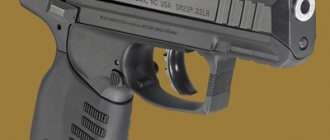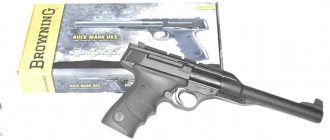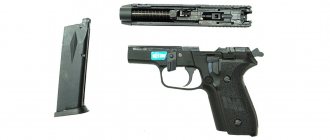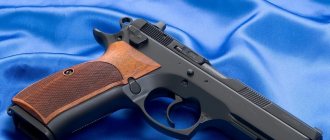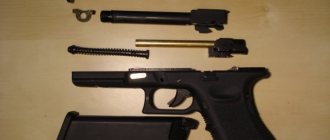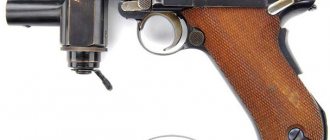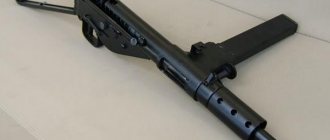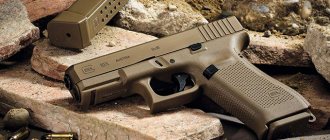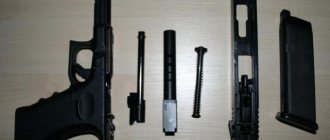Semi-automatic pistol
Type of semi-automatic pistol
| Ruger Standard | |
| Blued Ruger Standard with wood handles | |
| Type | Semi-automatic pistol |
| Place of origin | United States |
| Production history | |
| Designer | William Ruger |
| Designed by | 1949 |
| Manufacturer | Sturm, Ruger |
| Produced | 1949–present |
| Options |
|
| Characteristics | |
| Barrel length |
|
| Cartridge | .22 long rifle |
| Action | recoil |
| Feeding system | 9 or 10 round box magazine |
| Attractions | Open sights, fixed and adjustable |
Standard Ruger Model
is a rimfire semi-automatic pistol introduced in 1949 as the first product manufactured by Sturm, Ruger & Co. , and was also a founding member of the .22 Long Rifle product line of cartridge pistols, including later iterations: MK II, MK III and MK IV. It is marketed as an inexpensive +.22 caliber rimfire designed for casual sport and target shooting and plinking. Designed by company founder William B. Ruger, the Standard and its descendants became the most popular and successful .22 caliber semi-automatic pistols ever produced. [12]
Development[edit]
Patent drawing for William B. Ruger's 1951 standard pistol design
Some time after World War II, firearms designer and entrepreneur Bill Ruger acquired a pair of World War II-era Japanese Nambu pistols from a returning U.S. Marine, which he successfully duplicated in his garage . [3] Using the Nambu silhouette and bolt system, Ruger created its first prototype, but lacked the venture capital needed to finance its implementation. When his wealthy friend and potential financial backer Alex Sturm was shown the Ruger-built 1949 prototype, he was impressed by its sleek, traditional aesthetic and its slight resemblance to the classic German nostalgia-inducing Luger P08 pistol.
Realizing that potential buyers would share his sentiments, Sturm quickly signed on board with an initial investment of $50,000 and the two teamed up to create what was to become an iconic American firearm manufactured by the company, Sturm, Ruger & Co. . [1] [2] Ruger's new product was called the "Standard" model. Intended as an inexpensive recreational and sporting product for outdoor, hunting and firearms enthusiasts, Ruger pioneered a number of simple and innovative manufacturing techniques used in the production of the new pistol, including the use of piano wire coil springs. in the lock instead of the flat springs that most manufacturers used at the time, and formed the receivers from two stamped sheet metal halves welded together.
These methods worked well with firearms that only had to withstand 0.22 surround fire pressure, and the cost savings allowed Sturm and Ruger to radically undersell competitors who were still using older and more expensive manufacturing techniques. [2] Donor Sturm, a lover of heraldry aficionado, contributed the company's trademark "Red Eagle" coat of arms emblem, which was displayed as a medallion on the left hilt panel. [1] [2] Favorable review published in American Rifleman magazine,
written by renowned firearms expert Major General Julian S. Hatcher, coupled with subdued advertising printed in the same magazine, aroused great public interest. [1] The new pistol had a reasonable and very competitive MSRP of $37.50. [4]
Checks from potential buyers soon appeared, but since Ruger was firmly rooted in "old school" financial responsibility, none of them were cashed until the pistols were shipped, setting the standard for a black-tie operation that served the company well. in future. After a few months, all the initial money was spent, but by then the first 100 Standard pistols had been built and distributed to the original customers. [2]
From its introduction in the fall of 1949, the new pistol was a success, and although it faced competition from the outset, it soon captured a significant share of the rimfire pistol market. Unfortunately, Alex Sturm did not live to see the corporation's ultimate success, dying prematurely from viral hepatitis in November 1951. [2] In a memorial and as a sign of respect and mourning, Ruger ordered the background of the Sturm eagle emblem to be changed from red to black on future models of the popular and successful firearms they produced and sold together. [12]
The Standard model remained in constant production in largely the same form for the next 33 years, but the new corporation eventually expanded the basic Standard archetype into a pistol product line, introducing several model variants. These took the form of offering additional barrel lengths and configurations, creating versions optimized for target shooting, and adding a stainless steel finish option. The line has also been improved with three mechanical upgrades to the "MK" series, Mk II, Mk III and Mk IV, in 1982, 2004 and 2016. [2] The MK II added a bolt that held the bolt open on the final round. and was also available in stainless steel. The MK II was available in a variety of barrel lengths; Lightweight barrels available in 4.75" (12.1 cm) and 6" (15 cm) lengths; 4" (10 cm), 5.5" (14 cm), 6.875" (17.46 cm) and 10" (25 cm), plus heavy tapered barrels at 5.25" (13.3 cm) and 6.875 inches (17.46 cm). All bull barrel or heavy tapered shotguns are Target models and feature sights consisting of an adjustable rear sight and a taller, wider front sight with an aggressive undercut to reduce glare. In 1999, 18 versions of this popular pistol could be found in the Sturm Ruger catalog, and with over 2 million sold, it eventually became the most popular and popular .22 automatic pistol of all time. [12]
"Ruger Standard Mk.I". How has this “bottle breaker” been winning hearts for seven decades now?
“William B. Ruger was born in New York City on June 21, 1916. He was always interested in firearms manufacturing and, while in school, often visited machine shops to learn manufacturing techniques. Already a student at a liberal arts college, he developed the basic design of a light machine gun." Source: Wikipedia.
The first “shooting model” was made in 1948. According to Ruger himself, “this should be a simple and inexpensive plinking model,” the place of which was vacant on the market at that time.
“Plinking is recreational shooting at various non-standard targets (beer cans, bottles, etc.).” Source: Wikipedia.
No sooner said than done! Together with his friend Alexander Sturm, William Ruger organized the production of the first batch of pistols in the garage, which was given the proud name “Red Barn”. Money for the development of “production”, $50,000, was borrowed from Alexander’s wealthy relatives, promising to return it in... well, as it turns out. It was then, in 1949, that William Ruger determined the main principle of his work.
Named after the names of its founding fathers, it churned out two thousand Ruger Standard pistols during 1949, which were sent to retail for $37 apiece. Externally, this “device” was similar to the Japanese Nambu pistol that Ruger brought home after serving in the US Marine Corps during World War II. The appearance on the market of a new simple and inexpensive pistol, terribly similar to the German Parabellum, produces the effect of a bomb exploding.
In 1949, the Ruger and Sturm company rented a small machine shop in Southport, Connecticut, where it began producing the Ruger Standard Model & Mk. I Pistol" in .22 caliber. The company paid off its debts, and after the tragic death of Alexander Sturm in a plane crash, Ruger became the sole “ruler” of his small “weapons empire.”
First creation. A pistol chambered for the “small cartridge” of .22 caliber, combining the most advanced technical solutions of its time and at the same time having a surprisingly low price, the Ruger Standard Mk. I" was simply doomed to success. They called this creation of Ruger as much as they could - “attractively simple”, charismatic, American long Luger (the American name for the Parabellum pistol). The popularity of this model is growing rapidly, and the market requires a huge number of these pistols.
Structurally, the Mk.I is simple to the point of genius. It is a blowback pistol that moves freely inside a cylindrical receiver. The bolt, protected by the receiver, is practically not contaminated. Spent cartridges are extracted to the right through a window in the receiver. The pistol is cocked using the rear part of the bolt protruding from the receiver, for which a conical notch is made on it. Single action trigger. The safety lever is located at the base of the handle. The sights are open and consist of a non-adjustable rear sight and front sight. Magazine capacity - 9 rounds. The barrel is conical or cylindrical, 140 or 174 mm long. The pistol frame consists of two stamped halves connected by a welding seam. The pistol handle is located at an angle of 120 degrees, very comfortable to hold. There is practically no return.
The Mk.I model was produced until 1982, after which the range of Ruger Standard pistols expanded significantly. There are specialized versions for sports competitions, options with silencers for the military and special forces, and elite limited editions for collectors.
"Ruger Standard Mark II" arr. 1982, received a magazine with a capacity of 10 rounds, equipped with a shutter stop, received an improved fuse, adjustable sights and a new trigger.
"Mk.II Tagit" model 1983 - a sports model for target (particularly accurate) shooting with a reinforced barrel 140 mm or 254 mm long. Made entirely of stainless steel.
In 1987, the Mk.II Government Target model was developed. An even more polished sports model.
The Ruger Mk. is being created for the special forces of the American Navy. II Amphibian". This pistol is called the fourth generation Ruger Standard. The personal weapons of combat swimmers are made entirely of stainless steel and have a barrel shortened to 50 mm. The pistol silencer is made of a single design with the receiver. The design allows you to shoot without pouring water from the muffler and barrel bore.
Today, Ruger Standard pistols are produced under modified steel and stainless steel markings and are called Mk.III. Over the years of production, more than two million “standard Rugers” were produced. It was this pistol, with a penny production cost and huge profits, that made it possible to become the No. 2 weapons company in America in general and No. 1 in terms of total production for the civilian market. Today, in addition to pistols, Sturm, Ruger & Co. produces rifles, revolvers, shotguns and spare parts for weapons from other manufacturers.
But even now, when William Ruger himself is no longer alive (he died on July 6, 2002 at the age of 86), the main income for the company continues to come from the Ruger Standard, a pistol that has become a cult and very expensive, despite its simplicity and low cost of production. . Nothing can be done, charisma...
Tags: history of weapons, shooting, America, pistol, weapons, inventions
Features[edit]
Standard (1949-1982)[edit]
A Ruger Standard pistol with adjustable sights, manufactured in 1963.
The standard model is an atypical design, lacking the bolt action found on conventional pistols, instead having a cylindrical bolt that rotates inside a tubular receiver, more typical of a rimfire rifle. The pistol's bolt has protruding "ears" at the rear, which are grabbed and pulled back to fire the first shot and cock the bolt. The standard model was originally blued carbon steel and fitted with a 4.75 in (12.1 cm) tapered barrel using a basic form of blowback action.
The magazine holds 9 rounds of .22 Long Rifle ammunition and is held in place with a catch on the bottom of the grip. Standard models came with a Patridge-style fixed iron sighting with the rear sight securely mounted in a dovetail. The grip panels are made of hard black checkered butaprene synthetic rubber with pistols manufactured before 1950 bearing the Red Eagle trademark originally designed by Alex Sturm. The safety manual on the standard model can only be engaged when the gun has been cocked, and the bolt can be locked open by activating the safety with the bolt held back. [2]
The bolt remained "white", and the raw steel visually contrasted with the blued receiver. [1] In 1954, a new model was added to the Standard line with a 6-inch barrel length. [2] In 1971, one of the few engineering changes ever made to the standard model occurred when the original 22-year-old receiver molding dies wore out. [2] In anticipation of changes following the introduction of the MK II series in 1982, the magazine follower extension slot on the grip was moved from the right to the left side.
This modification, designated the "A 100" frame modification, contributed to the eventual improvement of the Standard pistol by the addition of a bolt locking device as part of the eventual MK II upgrade. [2] Because of this change, pistol grip panels and older Standard model magazines cannot be used on pistols manufactured after 1971, but later magazines can still be used on pre-1971 weapons by moving the magazine follower button to the opposite side. . [2] When the standard model reached the end of its life in 1981, a special edition of 5,000 4.75-inch pistols made of stainless steel was produced. These pistols were shipped in special wooden cases engraved with Bill Ruger's signature.[2]
MK I Target (1950–1982)[edit]
Introduced in 1950, the Model MK I Target was essentially the same as the Standard pistol except that it had a 6.875 in (17.46 cm) barrel, adjustable trigger, Micro adjustable rear sight and front sight. trimming to reduce glare. [2] In 1952, a MK I Target version with a 5.25 in (13.3 cm) barrel was added to the line, but it was not produced until 1957, making it a collector's item today. [2] A 5.5 in (14 cm) heavy barrel version of the MK I Target became available in 1963, and it eventually became the most popular length for Ruger Target MK pistols. [2]Like their standard model brethren, the target models received a redesign of the A 100 handle in 1971 [2].
Ruger Mk1 Target
Ruger single action revolvers (USA)
Ruger Blackhawk (Flat-top, "three screw" or Old Model) image (c) www.gunblast.com
Ruger Blackhawk New Model - the most popular model
Ruger Bearcat New Model - a smaller and lighter small-bore revolver
Ruger Bisley New Model
Ruger Bisley Vaquero - a revolver with a Bisley grip and fixed sights
Ruger Single-Six New Model - small-bore revolver
Ruger Super Blackhawk - BIG BROTHER
Ruger Vaquero - a large-caliber revolver for competition shooting in a "cowboy style"
USM
: single action
Caliber
: .22LR (5.6mm) to .44 Magnum and .45 Colt (11.43mm)
Unloaded weight:
varies by model and barrel length
Length:
varies by model and barrel length
Barrel length:
typical 4 to 8 inches (102 to 205 mm)
Drum capacity:
6 rounds
American William Batterman Ruger, founder and chief designer of the American arms company Sturm, Ruger & Co., can be called one of the leading weapons designers in the United States of the second half of the twentieth century, and also to a large extent a trendsetter in this area.
In the early 1950s, it seemed to everyone in the United States that the place for single-action revolvers was in museums, collections, and the silver screen—the Western film genre was just emerging in these years. The Colt company curtailed production of the famous “Peacemakers” in 1941, and it seemed that the era of single-action revolvers had finally passed, but... William Ruger thought differently. Inspired by the success of its first independent development, the small-caliber Ruger Standard pistol, Ruger began production of the Ruger Single Six revolver in 1953. Externally copying the classic Colt Single Action Army M1873 (Peacemaker), the Single Six had a much more advanced firing mechanism with coil springs instead of flat ones and a firing pin mounted in a frame. In addition, Ruger used advanced precision casting technology in the production of parts, which reduced the cost of production. The Single Six revolver was designed for small-caliber 5.6mm rimfire cartridges - .22LR and .22WMR (Winchester Magnum Rimmed). In 1955, Ruger began production of a similar-design revolver chambered for the .357 magnum cartridge under the designation Ruger BlackHawk, and from that moment on, the BlackHawk became one of the most popular hunting revolvers in the United States. The following year, Ruger released a larger version of the BlackHawk chambered for the powerful .44 Magnum cartridge. Both versions of the BlackHawk, as well as the Single Six, sold very successfully, which allowed William Ruger to develop a line of single-action revolvers. In 1959, the Ruger Super BlackHawk revolver appeared, chambered for .44 Magnum and .45 Colt cartridges. Externally, the “super” differed from regular Blackhawks in that it had a straightened rear trigger guard, a larger frame, and a fuller-less cylinder for increased strength and weight. In addition, in 1958, the Ruger Bearcat .22LR revolver was introduced. Unlike the Single Six, the Bircat had a smaller, one-piece frame made of light alloy or steel and was more comfortable for long-term wear.
In 1973, Ruger radically changed the design of the trigger of its revolvers, introducing the so-called “transfer bar safety” - a patented safety device in the form of a transfer bar, which, when the trigger is pressed, fits into the gap between the striker and the trigger. Thus, even if the trigger is removed from the firing pin during loading or the trigger sear or firing pin is broken, an accidental shot is completely excluded - the trigger can hit the firing pin only when the trigger is fully depressed. Another special feature of this design is that the new trigger can be installed in the frame of Ruger revolvers produced BEFORE 1973. Thus, all Ruger single-action revolvers produced before 1973 were designated Old Model, and those released after 1973 were designated New Model. In addition, for older model revolvers, the unofficial designation “three screws” is also used - three screw heads are visible above the trigger on the frame of these revolvers, and on new model revolvers two pins are visible there. In addition, revolvers with adjustable sights manufactured before 1962 may be informally designated as a “flat top model”, since after 1962 on all models the frame in front of the rear sight was reinforced and thickened.
In 1985, the Ruger Bisley revolver appeared, differing from the Blackhawks in the shape of the handle and trigger, copied from the old Colt SAA Bisley target revolvers. Bisley series revolvers are available in the entire range of calibers - from .22LR to .44 Magnum.
In 1993, the Ruger Vaquero revolver appeared (Vaquero is Spanish for “cowboy”). This revolver has only fixed, non-adjustable sights and is aimed primarily at those who are interested in “cowboy-style shooting” - there is such a type of shooting sport in the USA. Iaquero is available in .357 Magnum, .44-40, .44 Magnum and .45 Colt calibers. The combination of a frame from a Vaquero revolver with a handle from a Bisley revolver went on sale in 1998 under the designation Ruger Bisley-Vaquero, chambered for .44 Magnum and .45 Colt cartridges.
In general, all Ruger revolvers with single action triggers have a similar design. All revolvers (with the exception of Bearcat) have a frame made of two parts - the frame itself and the handle with the trigger guard (Bircat has a solid frame). For a number of models, the handle is cast from an aluminum alloy; for models chambered for more powerful cartridges, the handle is made of steel. The USM mainsprings are twisted, the firing pin on all models is mounted in a frame, and since 1973, a safety transfer bar between the trigger and the firing pin has been introduced into the USM design. Loading and unloading revolvers is done one cartridge at a time, through the door on the right side of the frame, which folds to the side. Unlike traditional Colt SAA revolvers, to release the cylinder when reloading, you do not need to put the hammer on the safety cock - just open the charging door. Removal of spent cartridges is carried out using a spring-loaded rod extractor located in a case rigidly fixed to the right under the barrel, opposite the loading door. Sights include a front sight and a fixed or adjustable micrometric rear sight.
So, despite the archaic nature of the very concept of single-action revolvers, William Ruger revolvers are modern weapons, very popular for hunting and recreational shooting. Moreover, I know that in the United States there are several police departments that issue Ruger BlackHawk .357 Magnum revolvers to police officers as standard service weapons! All Rugers are famous for their high reliability and survivability, good shooting accuracy and, importantly, reasonable prices.
MK II[edit]
This section is about the semi-automatic rimfire pistol. For the bolt-action rifle produced by the same company, see Ruger M77 Mark II.
Type of semi-automatic pistol
| Ruger MK II | |
| Ruger Mark II Target | |
| Type | Semi-automatic pistol |
| Place of origin | United States |
| Production history | |
| Manufacturer | Sturm, Ruger & Co. |
| Produced | 1982–2005 |
| No. built | 3 000 000+ |
| Characteristics | |
| Weight | 46 oz. (w/6 7 ⁄ 8 in. drum) |
| Length | 11 1/8" (w/6 7 ⁄ 8" drum) |
The MK II ("Mark Two") was produced from 1982 to 2005. It replaced Standard
, Ruger's first model, produced from 1949 to 1982, and
the MK I Target
, produced from 1951 to 1982.
MK II variants include Target models.
, which have heavier barrels and adjustable sights, and the
22/45
, which have a polymer frame with a grip angle that matches the Colt 1911 rather than a steel frame like the Luger P08. Three types of barrels are available. Conical barrels were available in 4 3/4", 6" and 6 7/8" lengths, and could be equipped with fixed sights in any length or adjustable sights on 6" and 6 7 ⁄ 8" long barrels. Bull barrels were available on the Mark II in 5 1/2", 6 7 ⁄8" and 10" long, all with adjustable sights. Single sided target plate models were available with 5 1/2" and 6 7 ⁄ 8" barrels and adjustable sights. All Ruger Mark II pistols were available in either a blued finish or stainless steel, with the exception of the plate-side Target models, which came in stainless steel only. The MK II was discontinued in 2004, when it was replaced by the MK III. All Ruger rimfire pistols are chambered only in .22 Long Rifle caliber.
Options [edit]
Title II AWC TM - Amphibian "S" variant with integrated suppressor used by the US Navy SEALs.
Ruger Mark II Stainless Slab side Competition Target Model +0.22 LR pistol with Volquartsen profiled plates on the V-Comp side compensator, red dot sight mounted on a Volquartsen Weaver style rail, 6 7/8, precision barrel crown, and checkered thumb the rest of the target captures
Some special variants that command higher prices are the Government Target model, a model that was used for pistol training and competition by the United States Army,[ edit]
] and the Red Eagle model, which have been made since 1949 by the company co-founder Alexander Sturmsmert in 1951. Red Eagle models featured a red Ruger logo on a silver background. Since then, the Ruger logo on the grips has been either black on silver or silver on black, with the exception of the special 50th Anniversary model, which had a silver eagle on a red background. The top-of-the-line Government Target model comes with a 6.875-inch (17.46 cm) support barrel and wood grips with a thumb rest. The competition target model is identical to the government target model with the addition of flat edges cut along each side of the barrel to reduce weight. Sometime during the production of the Mark II, Ruger began drilling their receivers and providing low profile scope bases and 1-inch scope rings. With the addition of a pistol frame or red dot, this makes the perfect entry-level pistol bullseye.
The suppressed Mk II was used by US Navy Seals. [5] This variant is significantly quieter than the standard Mk II and is accurate to 70 m (230 ft). [6]
The AWC TM-Amphibian "S" is a suppressor variant of the Ruger Mk II Target .22 LR pistol. The muffler uses a 303 stainless steel primary baffle and a 6061-T6 aluminum alloy secondary baffle. The AWC weapon manual states: “This suppressor is “amphibious” and can be shot with water. You can add a couple of tablespoons of water to the muffler for extra quiet operation.” [7] It reliably fires both standard and high-velocity ammunition and has a US Navy specification brushed stainless finish. The pistol has an overall length of 13.25 inches (33.7 cm), a suppressor length of 7 inches (18 cm), a diameter of 1 inch (2.5 cm) and a weight of 41 ounces (1200 g). [8] These weapons are classified as Title II weapons in the United States. and requires $200 transfer or production tax in addition to ATF registration.
Silent pistol "Emphibian" for landing operations
When conducting special operations, it is often necessary to operate in water. The mission may involve disembarking from a submarine and then boarding a surface vessel, landing in the open ocean to reach an enemy shore, or going upstream into enemy territory. Those who perform such varied tasks are especially vulnerable when they leave the water. At this moment, the success or failure of the operation may depend on the ability to immediately and quietly remove an enemy sentry or scout. Before shooting, it is necessary to remove water from the barrel and muffler. This takes time, and sometimes it is much more expensive than money. The Emphibien pistol is different in that you can be underwater with it, and then shoot without completely removing the water from the system. Moreover, a small amount of water in the weapon will simply reduce the sound of the shot.
The Emphibien II pistol, currently offered by the , represents the fourth generation of this system. The Emphibian pistol is based on the Ruger Model II pistol, made of stainless steel. The barrel is shortened, its length is less than 50 mm. Four holes have been added in the chamber area. Placing the holes close to the chamber offers some advantages. Fewer are required, and the diameter of the holes can be significantly reduced. In addition, powder gases have very high temperatures and speeds in the hole area. Apparently, thanks to this, hot gases blow through the holes with each shot, removing powder deposits. Unburned gunpowder residues could clog the discharge holes after one or two thousand shots, if no special measures were provided in the design itself. The short barrel and the special design of the release holes, necessary for operations in amphibious operations, reduce the pressure on the bolt, which operates the automatic mechanism. Therefore, the Emphibien pistol may require a burn-in period of about 1000 rounds to achieve maximum reliability on high and standard muzzle velocities, which in this pistol produce subsonic muzzle velocities. And although in this system cartridges with subsonic muzzle velocity will not provide reliable operation, this fact cannot in any way be considered a design flaw. Emphibien has been specially developed to ensure optimal performance with high-velocity cartridges. AWC never intended to use standard or subsonic muzzle velocity cartridges for this pistol. But it should be noted that even with high-velocity cartridges, due to the reduced gas pressure on the action, more thorough cleaning and lubrication is required than for a conventional pistol or any other competing model of a silent pistol like the Gemtech Operator. This is the small price that had to be paid for the system’s adaptability to use in amphibious assault conditions. The Emphibien pistol is made entirely of grade 300 stainless steel. The first version of the Emphibien I used complex diaphragms made from a square pipe located perpendicular to the axis of the muffler. Diaphragms diverted powder gases to perforated conical gaskets, which formed coaxial expansion chambers.
The second version of the Emphibien pistol uses 11 perforated cones with an inclined rear end surface. In the third option, perforated conical gaskets are simply used as diaphragms. The shortened Emphibien II pistol uses a completely different diaphragm design, similar to that used in the Model II suppressor chambered for the 9mm cartridge, developed by AWC for ultra-short range combat. This design is protected by US Patent No. 4,588,043, as well as patents in Europe, Australia and South Africa held by Mickey Finn; it is distinguished by the shape of the side wall. It has a diagonal slot that forms a channel extending from the rear surface of the diaphragm to the opposite side of the front surface. For all options, the internal parts are welded to each other with high precision before installation in the muffler casing. This ensures sealing of the casing along its entire length. This approach, given the complex internal structure of the muffler, is quite logical. The Emphibien I tested by the author (serial number 89-58) is the first design to use a type of diaphragm developed by AWC for silencers for the 7.62 mm McMillan M89 sniper rifle. These suppressors were manufactured under contract to the US Navy. The total length of "Emphibian I" is 343 mm, weight is 1195 g. The muffler body has a length of 204 mm and a diameter of 25 mm. "Emphibien II" (serial number D-521) has a total length of 324 mm and weighs 1243 g. The length of the muffler body is 192 mm, the outer diameter is 25 mm. The methodology used to evaluate these pistols is described below. The Emphibien pistols were compared to a Ruger pistol without a silencer, which has a barrel length of 140 mm. High-velocity "High Power" cartridges and standard muzzle velocity target cartridges were used. The ambient temperature was 6 degrees Celsius, and the speed of sound was 335 m/s. Those readers who do not have an intuitive understanding of how to interpret noise measurement data will benefit from reading the short box “Interpreting Noise Measurement Data” before diving into the data below. This item is not complicated, but it is simply different from the measurements that most people use in their daily lives. The unsuppressed Ruger pistol produced a noise level (maximum sound pressure level) of 153 dB with high-velocity ammunition and 152 dB with standard-velocity ammunition. Emphibien I produced noise levels of 117 dB with high-velocity and 115 dB with standard cartridges, which gives a corresponding reduction in noise levels of 36 dB and 37 dB. The Emphibian II produced a noise level of 115 dB with high-velocity cartridges and 113 dB with standard cartridges, which corresponds to a reduction in noise levels of 38 dB and 39 dB, respectively.
MK III [edit]
| This section requires additional links for verification . |
Pistol type
| Ruger MK III | |
| Ruger MK III Target with 5 1/2" bull barrel | |
| Type | Pistols |
| Place of origin | United States |
| Production history | |
| Manufacturer | Sturm, Ruger & Co. |
| Produced | 2004–2016 |
| Options | View models |
| Characteristics | |
| Weight | 31–45 oz (880–1,280 g) [9] |
| Length | 9–11.12 in (229–282 mm) [9] |
| Barrel length | 4.75 - 6.88 in (121 - 175 mm) [9] |
| Barrels | 1:16 “Right twist [9] |
The MK III ("Mark Three") is the third generation successor to the original Ruger Standard. The MK III replaced the MK II in 2004, and MK III production ended on December 8, 2016; it was replaced by the MK IV.
Differences from Mark II[edit]
- Adding a visible loaded camera indicator on the left side.
- The magazine release has been moved from the bottom of the grip to the rear of the trigger guard.
- All Mark III pistols with adjustable sights are drilled and tapped to accept the Weaver style sight mount that comes with the pistol. [10]
- A new magazine release prevents the pistol from firing when the magazine is removed from the pistol.
- Added internal fuse. Using a key, the fuse can be locked in the “safe” position.
- Shorter tapered bolt ears.
- Smooth ejection port profile.
Models[edit]
Mark III [edit]
Ruger Mark III stainless steel with magazine
The first model range is known simply as the Mark III
. The pistol barrel is made of steel rod and is inserted into a receiver made of steel pipe. However, the barrel cannot be removed without machining. The layout is similar to the Luger P08, although the operating mechanism was originally copied from the Nambu pistol.
- The top-end model is known as the Hunter
.
This pistol has a stainless steel frame and comes with a 4.5-inch, 5.5-inch (distributor exclusive), or 6.875-inch fluted barrel, fiber optic front sight, adjustable V-notch rear sight and half-length rear sight. -checkered cocobolo wood handle. It has several security mechanisms, and includes a visible loaded chamber indicator (the first ever included in a .22 rimfire pistol)[ edit
] as well as internal and external locks provided. - The next pistol in the line is called Competition
. It also has a stainless steel frame and a 6.875-inch flat barrel that is fully adjustable; The pistol also has a cocobolo grip with a thumb rest. - The target
is the next Mark III. This pistol has a stainless or blued finish, a 5.5-inch barrel, an adjustable rear sight, black plastic grips on a blued finish, and Cocobolo grips on a stainless finish. - The bull
pistol barrel comes in a stainless steel or blued finish. It has a heavier barrel to prevent overheating of the barrel and minimize recoil. Has a 5.5-inch barrel and adjustable rear sights. - Finally, the Standard
Mark III has a tapered barrel, black plastic grips, and a blued finish. It comes with a 6" or 4.75" barrel. Has fixed sights.
Ruger Mark III Lineup
| Catalog number | Model | End | Sight | Length | Approx. weight | ||||
| Blued | Stainless | Rear | Front | Barrel | General | ||||
| Standard | MKIII4 | Standard | * | Fixed | Fixed | 4 3 / 4 « | 9 « | 35 oz. | |
| MKIII6 | Standard | * | Fixed | Fixed | 6 inches | 10 3 / 4 « | 37 oz. | ||
| Target | MKIII512 | Bull Bbl. | * | Adjustable | Fixed | 5 1 / 2 « | 9 3 / 4 « | 42 oz. | |
| KMKIII512 | Bull Bbl. | * | Adjustable | Fixed | 5 1 / 2 « | 9 3 / 4 « | 42 oz. | ||
| KMKIII678GC | Competition | * | Adjustable | Fixed | 6 7 / 8 « | 11 1 / 8 « | 45 ounce | ||
| KMKIII678H | Hunter | * | Adjustable | HiViz fiber optic cable | 6 7 / 8 « | 11 1 / 8 « | 41 ounces | ||
| KMKIII45H | Hunter | * | Adjustable | HiViz fiber optic cable | 4 1 / 2 « | 8 3 / 4 « | 38 oz. | ||
Mark III 22/45[edit]
Mark III 22/45 with 5.5" bull barrel
Mark III 22/45 Lite
Mark III 22/45 Lite custom with holographic sight and barrel compensator
The second model range was named Mark III 22/45
. These pistols have a polymer frame and a steel barrel that is almost permanently mounted in a tubular steel receiver. The grip angle mimics the M1911 grip angle.
- The current high-end Mk III 22/45 Lite
was introduced at the 2012 SHOT Show. Key features include a lightweight aluminum upper receiver, lowering material on the upper receiver for improved appearance and additional weight savings, a steel barrel that has been threaded 1 /2"-28 for the compensator or suppressor, and the interchangeable grip user Finally, the
Lite
model's receiver is drilled and tapped for the included Weaver rail section. - The previous high-end model is known as the Hunter
. This pistol features a 4.5- or 6.875-inch stainless steel barrel, a HiViz fiber optic front sight, and an adjustable rear sight. This model was discontinued for 2012. - The Target
Pistol comes in several different variations. It has a heavier barrel to limit overheating, reduce recoil and improve accuracy. 5.5" stainless steel barrel and adjustable rear sights (discontinued 2012). - Blued finish with a 5.5-inch barrel and adjustable rear sight.
- Blued finish with a 4-inch barrel and adjustable rear sight.
- Blued finish with a 5.5-inch barrel, fixed rear sights and interchangeable Cocobolo checkered grips.
- Some models formerly sold as the Bull Barrel
and
Slab Side
were modified or discontinued entirely when Ruger changed its catalog to reflect the
Target
.
models are very similar in configuration to
the target
models, but with a threaded barrel to add a compensator or suppressor. These models also feature interchangeable grips and the ability to mount adjustable sights or Picatinny rails.
models for
distributors
are specially built versions of the Mk III 22/45 released by select distributors. For the 2012 model year, these models include:
- Target
model with Brown Digital Camo "Water Dog" lower receiver.
model with fluted barrel and adjustable rear sight.
model features a fluted barrel and an adjustable fiber optic rear sight.
Ruger Mark III 22/45 lineup (as of June 2012)
| Catalog Number | Model | End | Sight | Length | Approx. weight | ||||
| Blued | Stainless | Aluminum | Rear | Front | Barrel | General | |||
| P45MK3ALRP | Lite | * | Adjustable | Fixed | 4 1 / 2 « | 8 1 / 2 « | 22 oz. | ||
| P4MKIII | Target | * | Adjustable | Fixed | 4 inches | 8 « | 31 ounces | ||
| P512MKIIIRP | Target | * | Fixed | Fixed | 5 1 / 2 « | 9 1 / 2 « | 33 oz. | ||
| P512MKIII | Target | * | Discount. | Adjustable | Fixed | 5 1 / 2 « | 9 1 / 2 « | 35 oz. | |
| P45GMK3RP | Threaded | * | Fixed | Fixed | 4 1 / 2 « | 8 1 / 2 « | 32 oz. | ||
| P45GMK3PRRP | Threaded | * | Picatinny rail | Nobody | 4 1 / 2 « | 8 1 / 2 « | 32 oz. | ||
| KP512MKIII | Bull Barrel | * | Adjustable | Fixed | 5 1 / 2 « | 9 1 / 2 « | 35 oz. | ||
| KP678HMKIII | Hunter | * | Adjustable | HiViz fiber optic cable | 6 7 / 8 « | 10 7 / 8 « | 34 oz. | ||
RUGER 22/45 family of semi-automatic small-bore pistols
The RUGER 22/45 series pistols are specifically designed for training with .45 caliber pistols such as the M1911A1, sporting competitions and small game hunting. Can be used in special forces, armed civil services and operatives. The price range of the Ruger 22/45 series pistols is from $349 to $469.
At the end of the last century, another modification of the Ruger small-caliber .22 caliber pistol appeared. The model is called Ruger 22/45. Its grip is the same as that of the Colt M1911A1 pistol, and it is located at a 17-degree angle, with all weapon controls located on the left side of the pistol. The body of the weapon is made of modern synthetic materials. Pistols are perfect for using a silencer when shooting, as there is an ideal place to install it. The magazine capacity for the entire Ruger 22/45 series is 10 rounds.
The Ruger 22/45 grip frame is injection molded and the grip material is glass-filled Zytel nylon. Such nylon is not exposed to environmental influences, does not break, crumble or delaminate. The designers assure that the use of such nylon has a positive effect on reducing sound pressure. The magazine latch was moved to all firing control parts on the left side; on standard Rugers it is located at the base of the grip frame. This design is increasingly reminiscent of M1911A1 pistols. The safety lever is made on the pistol exactly like on the Colts, the same arrangement as on the previous Rugers of the Mark II series. To open fire from a pistol, you simply move the lever down. When the safety locks the bolt, the safety mechanism will also lock the release lever, and when it is pressed on the hook, forward rotation will be blocked and the firing pin will not be released. The release button, the shutter delay, has approximately the same location on the weapon as the shutter stop lever of the M1911A1 pistol. The last shot triggers the delay; the button on the magazine causes the flat lever in the handle frame to rotate upward and hold the bolt in the rear extreme position. The barrel box for the Ruger 22/45 is made from stainless steel seamless large-wall pipes, series 400 stainless steel, which are processed on high-precision machines. The resulting barrels are .22 caliber and have a 6-point right-hand thread with a 16-inch pitch. Oxidized chromium-nickel steel is used to create the shutter. A company mark is placed on the rear end of the bolt. The reflector is made of stainless stamped steel and is qualitatively mounted on the barrel box. The spring-loaded reflector consists of 2 parts. The spring-loaded firing pin is limited along the way by a transverse rod located perpendicular to the bolt. There is a return type spring on the guide rod; it is located above the bolt.
The trigger handle for pistols of the entire Ruger 22/45 series is made of aluminum with a corrugated surface. The designed trigger pull was 3.5 pounds, which provided a smooth transition and easy trigger. Some pistols come with suppressors. It is 7.5 inches long, bringing the overall length of the pistol to 13 inches, and the pistol weighs just over 2 pounds. The muffler is made of steel, series 304. The baffles are made of aluminum alloys. The muffler has an adjustable front sight and an adjustable rear sight with a square slot.
The bolt lock, installed on pistols used by special forces, is very simple and effective, a slight turn of the bolt (10 degrees) and the bolt is locked, the sound level of using the pistol will decrease, and the spent cartridge case will not leave the weapon, which is sometimes necessary for non-standard operations. The set of the pistol with a silencer includes a special design for using the pistol in non-standard conditions. Case material – Cordura nylon. The case has a pocket into which the Spyderco Slipit Endura knife, produced by the same Arms Tech Inc, fits. This kit is called the “operative kit”. In the same pocket you can carry a spare magazine, and with frequent use, the pistol can be quickly removed from the case for its intended use.
MK IV [edit]
Type of semi-automatic pistol
| Ruger MK IV | |
| Type | Semi-automatic pistol |
| Place of origin | United States |
| Production history | |
| Manufacturer | Sturm, Ruger & Co. |
| Produced | 2016–present |
| Options | View models |
| Characteristics | |
| Weight | 25.0–53.5 oz (710–1,520 g) |
| Length | 8.4 - 14.0 in (210 - 360 mm) |
| Barrel length | 4.4 - 10.0 in (110 - 250 mm) |
| Barrels | 1:16 “Right twist [11] |
The MK IV ("Mark Four") is the fourth generation successor to the original Ruger Standard. Introduced in 2016, the MK IV succeeds the MK III.
Differences from Mark III[edit]
The most important feature of the Mk IV conversion is the articulation between the upper receiver and the grip frame. This design allows the user to disassemble the firearm, greatly simplifying the process compared to previous models. [12]
Other design changes include: a redesigned trigger group, a redesigned slide stop, an ambidextrous thumb safety, and a non-dropout magazine release mechanism. [12]
Safety review [edit]
In June 2022, Ruger issued a safety recall on the MK IV due to a faulty trigger and safety mechanism. If the safety was midway between the "safe" and "fire" positions when the trigger was pulled, the gun could fire when the safety was moved to the "fire" position. MK IV vehicles with serial numbers beginning with "401" (2022 models) or "WBR" (2016 models) have been recalled. [13] [14]
Models[edit]
| MK IV partially disassembled; pay attention to the hinge between the receiver and the handle |
Ruger Mark IV lineup (as of October 2022)
| Catalog number | Model | End | Sight | Length | Approx. weight | Notes | Ref. | |||
| Barrel | Grab | Rear | Front | Barrel | General | |||||
| 40101 | Target | Blued | Aluminum | Adjustable | Fixed | 5.50 « | 9,75 « | 35.6 oz. | [15] | |
| 40103 | Target | Stainless | Stainless | Adjustable | Fixed | 5.50 « | 9,75 « | 42.8 oz. | [16] | |
| 40104 | Standard | Blued | Aluminum | Fixed | Fixed | 4,75 « | 9.00 « | 28.2 oz. | [17] | |
| 40105 | Standard | Blued | Aluminum | Fixed | Fixed | 6.00 « | 10.25 « | 30.1 oz. | [18] | |
| 40107 | 22/45 | Blued | Polymer | Adjustable | Fixed | 5.50 « | 9,75 « | 34.4 oz. | [19] | |
| 40112 | Competition | Stainless | Stainless | Adjustable | Fixed | 6,88 « | 11,12 « | 45.8 oz. | [20] | |
| 40118 | Hunter | Stainless | Stainless | Adjustable | Optical fiber | 6,88 « | 11,12 « | 44.0 oz. | [21] | |
| 40126 | Target | Stainless | Stainless | Adjustable | Fixed | 5.50 « | 9,75 « | 42.8 oz. | Threaded barrel | [22] |
| 40149 | 22/45 Tactical | Blued | Polymer | Adjustable | Fixed | 4,40 « | 8,50 « | 33.3 oz. | Threaded barrel | [23] |
| 40150 | Tactical | Blued | Aluminum | Adjustable | Fixed | 4,40 « | 8,50 « | 34.6 oz. | Threaded barrel | [24] |
| 40159 | Target | Blued | Aluminum | Adjustable | Fixed | 5.50 « | 9,75 « | 35.8 oz. | Target Laminate Grips | [25] |
| 40160 | Hunter | Stainless | Stainless | Adjustable | Optical fiber | 6,88 « | 11,12 « | 44.2 oz. | Target Laminate Grips | [26] |
| 40167 | 22/45 Tactical | Cerakote | Polymer | Adjustable | Fixed | 4,40 « | 8,50 « | 33.3 oz. | Threaded barrel | [27] |
| 40172 | Hunter | Stainless | Stainless | Adjustable | Optical fiber | 4,50 « | 8,50 « | 38.5 oz. | [28] | |
| 40173 | Target | Blued | Aluminum | Adjustable | Fixed | 10.00 « | 14.00 « | 46.3 oz. | [29] | |
| 40174 | Target | Stainless | Stainless | Adjustable | Fixed | 10.00 « | 14.00 « | 53.5 oz. | [30] | |
| 43921 | 22/45 Lite | Anodized (gray) | Polymer | Adjustable | Fixed | 4,40 « | 8.40 « | 27.0 oz. | Target Laminate Grips | [31] |
| 43910 | 22/45 Lite | Anodized (red) | Polymer | Adjustable | Fixed | 4,40 « | 8.40 « | 25.0 oz. | Threaded barrel | [32] |
| 43915 | 22/45 Lite | Anodized (Purple) | Polymer | Adjustable | Fixed | 4,40 « | 8.40 « | 25.0 oz. | Threaded barrel | [33] |
| 43916 | 22/45 Lite | Anodized (olive gray) | Polymer | Adjustable | Fixed | 4,40 « | 8.40 « | 25.0 oz. | Threaded barrel | [34] |
| 43924 | 22/45 Lite | Anodized (cobalt) | Polymer | Adjustable | Fixed | 4,40 « | 8.40 « | 25.0 oz. | Threaded barrel | [35] |
| 43926 | 22/45 Lite | Anodized (gold) | Polymer | Adjustable | Fixed | 4,40 « | 8.40 « | 25.0 oz. | Threaded barrel | [36] |
| 43927 | 22/45 Lite | Anodized (black) | Polymer | Adjustable | Fixed | 4,40 « | 8.40 « | 25.0 oz. | Threaded barrel | [37] |
| 43934 | 22/45 Lite | Anodized (gray) | Polymer | Adjustable | Fixed | 4,40 « | 8.40 « | 25.0 oz. | Threaded barrel | [38] |
Exclusive models for distributors
Links[edit]
- ^ B s d e g Quinn, Boge. "Ruger 50th Anniversary .22" Gunblast Website. Accessed January 8, 2009
- ^ abcdefghijklmnopqrs Metcalfe, Dick. "50 Years of Ruger Autopistols" website. Accessed 13 January 2009
- Wilson, R.L. “Ruger and his guns; the story of a man, a company and their firearms.” 1996. ISBN 0-7858-2103-1.
- Website for Nazarian's "Ruger MKI/MKII/MKIII" Weapon Recognition Guide. Accessed January 8, 2009
- "Jane's International Defense Review". Jane's International Defense Review
. Janes Information Group (3). 1996. SEALs can be equipped with a wide variety of small arms, ranging from the Ruger Mk 2 .22 caliber (LR) to... - Handbook of World Weapons
. p119: Blitz Editions. 1996. ISBN 1-85605-348-2.CS1 maint: location (link) - LW McWilliams. TM-Amphibian 'S' Manual
. AWC Systems Technology, 2001. p. 3. - AWC Product Guide, 2009
, pp. 5–6. - ^ abcd "Ruger Mark III". Sturm, Ruger & Co., Inc. Retrieved December 8, 2012.
- The Ruger manual states: “NOTE C: Scope bases and scope rings shown will fit all MARK III and 22/45 MARK III pistols. Only MARK III Target models are factory drilled and tapped. Standard MARK III models must be drilled and tapped by your local gunsmith (Drilling and tapping instructions are available upon request.) “As of March 2011, it appears that Ruger has begun drilling and tapping on the standard MARK III model.
- "Ruger Mark IV". Sturm, Ruger & Co., Inc. Retrieved December 14, 2016.
- ^ ab "Ruger Introduces Mark IV One-Button Takedown Pistol". American shooter
. September 22, 2016. Retrieved December 14, 2016. - Journal, Richard Craver Winston-Salem. "Ruger Orders Recall of All Mark IV Pistols". Winston-Salem Journal
. Retrieved May 4, 2022. - "Ruger Remembers Mark IV Rimfire Pistols". www.showillustrated.com
. Retrieved May 4, 2022. - https://ruger.com/products/markIVTarget/specSheets/40101.html
- https://ruger.com/products/markIVTarget/specSheets/40103.html
- https://ruger.com/products/markIVStandard/specSheets/40104.html
- https://ruger.com/products/markIVStandard/specSheets/40105.html
- https://ruger.com/products/markIV2245/specSheets/40107.html
- https://ruger.com/products/markIVCompetition/specSheets/40112.html
- https://ruger.com/products/markIVHunter/specSheets/40118.html
- https://ruger.com/products/markIVTarget/specSheets/40126.html
- https://ruger.com/products/markIV2245Tactical/specSheets/40149.html
- https://ruger.com/products/markIVTactical/specSheets/40150.html
- https://ruger.com/products/markIVTarget/specSheets/40159.html
- https://ruger.com/products/markIVHunter/specSheets/40160.html
- https://ruger.com/products/markIV2245Tactical/specSheets/40167.html
- https://ruger.com/products/markIVHunter/specSheets/40172.html
- https://ruger.com/products/markIVTarget/specSheets/40173.html
- https://ruger.com/products/markIVTarget/specSheets/40174.html
- https://ruger.com/products/markIV2245Lite/specSheets/43921.html
- https://ruger.com/products/markIV2245Lite/specSheets/43910.html
- https://ruger.com/products/markIV2245Lite/specSheets/43915.html
- https://ruger.com/products/markIV2245Lite/specSheets/43916.html
- https://ruger.com/products/markIV2245Lite/specSheets/43924.html
- https://ruger.com/products/markIV2245Lite/specSheets/43926.html
- https://ruger.com/products/markIV2245Lite/specSheets/43927.html
- https://ruger.com/products/markIV2245Lite/specSheets/43934.html
- Wilson, R.L. Ruger and His Guns: The Story of a Man, a Company and Their Firearms
. 1996. ISBN 0-7858-2103-1.
